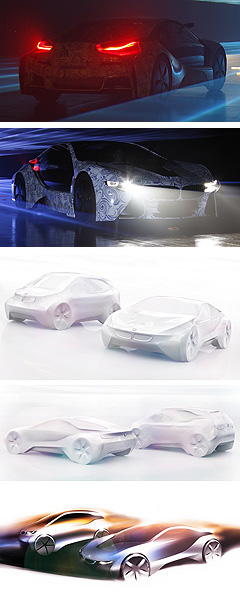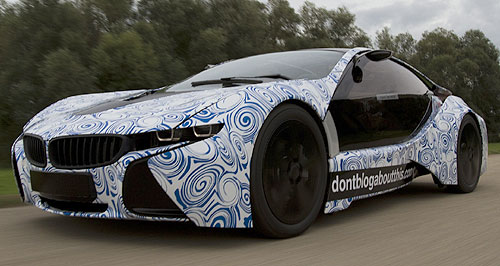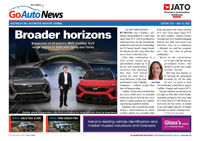Future models - BMW - i8Plug-in BMW coupe confirmed for OzFuture glimpse: BMW's Vision EfficientDynamics concept will be at the Australian International Motor Show in Melbourne from July 1. BMW confirms plug-in i8 supercar - and the concept that previews it – for Australia3 Jun 2011 BMW has formally confirmed the Australian release of the i8 plug-in hybrid super-coupe, which will be previewed by the wild scissor-doored Vision EfficientDynamics concept that will make its local debut at the Australian International Motor Show (AIMS) in Melbourne from July 1. As we revealed earlier this week, BMW will depart from tradition by booking a relatively tiny 264 square-metre AIMS stand to stage the local premiere of the futuristic Vision ED, which made its global debut at the 2009 Frankfurt motor show. Today BMW officially announced its return to AIMS with “hero car” exhibit - the Vision ED’s “first and last” Australian appearance. “Through the Australian International Motor Show in Melbourne, we have the rare opportunity to show a concept car to Australians that exhibits everything that BMW represent in terms of sustainable future mobility, and our dedication to improving efficiency, minimising emissions whilst never compromising the performance BMW is famous for,” said BMW Australia managing director Phil Horton. The Bavarian auto-maker announced its all-new green-focussed ‘BMW i’ sub-brand in February, when the i8 super-coupe and the model formerly codenamed MegaCity Vehicle, the i3 hatchback, were confirmed for global release in 2013 via a new BMW i website.  Left: BMW Vision EfficientDynamics. Below: BMW i3 and i8 concepts. Left: BMW Vision EfficientDynamics. Below: BMW i3 and i8 concepts.At the time, BMW Australia head of corporate communications Piers Scott confirmed that the sub-brand would be rolled out in this country, but cautioned that it was unlikely to happen in 2013. “The working title for the i3 is the MegaCity Vehicle, and its primary application and intended market is major, densely populated metropolises,” he said. “So, I suggest that’s where the focus will be. “It is a worldwide sub-brand, but in terms of details of the arrival of the new i3 and i8 into Australia, it is far too early to say. “But it is certainly a range of products that we are very excited about bringing to Australia whenever that time may be.” Mr Horton has now officially confirmed both ground-breaking new BMW i models will be made available to Australians, but provided no specific timing. “This is a vehicle that proves sustainable motoring can still be an enthralling experience and Australians will be able to enjoy this for themselves when it goes into production in the form of the BMW i8,” he said. “The Vision EfficientDynamics concept is proof that maximising the efficiency and emissions of motor vehicles through BMW EfficientDynamics technologies does not have to mean under-performing cars, because creating the Ultimate Driving Machine will always sit at the heart of every car we produce.” As we’ve reported, the new BMW i models will not only herald the Munich maker’s electric age but also a new purpose-built vehicle architecture comprising two separate ‘LifeDrive’ modules: an aluminium chassis housing the electric drivetrain and batteries, topped by a carbon-fibre-reinforced plastic (CFRP) body – a first for a mass manufacturer. The BMW i3 will be the company’s first series-produced electric vehicle. It will be joined by the i8 in BMW’s Leipzig plant, which will get a €400 million ($A542m) makeover to handle the new body assembly system and is eventually expected to produce up to 40,000 i-cars annually. BMW has confirmed that both vehicles will share the same electric motors, power electronics and high-voltage lithium-ion batteries, but the mid-engined four-seater i8 coupe will gain an internal combustion engine to charge the batteries for greater range. If the Vision EfficientDynamics concept is any guide, it will be a 120kW alloy-block 1.5-litre three-cylinder common-rail turbocharged diesel that will also power the new 1 Series hatch due around the same time. The 1240mm-high Vision ED concept’s drivetrain comprised two electric motors – a large 82kW unit driving the front wheels and a smaller 39kW motor that helped the diesel engine drive the rear wheels via a six-speed dual-clutch gearbox. Electronic controls apportioned drive to all four wheels, with the prototype boasting a combined 241kW – enough to propel it from zero to 100km/h in just 4.8 seconds. The show car’s rechargeable lithium-polymer batteries – housed longitudinally in a central chassis element - could be recharged at a conventional power socket in two and a half hours, providing electric propulsion for up to 50km, or up to 700km via its 24-litre diesel fuel tank. With claimed fuel consumption of just 3.67 litres per 100km and CO2 emissions of just 99 grams per kilometre, the sleek Vision ED – which also boasts an aerodynamic drag coefficient of just 0.22Cd - delivers hybrid-like efficiency with the performance of a bona fide sportscar. The all-electric i3 city-car, meantime, is also expected to break new ground in the its segment by featuring BMW’s trademark rear-wheel drive layout – something that will not be seen on a future BMW model to be positioned between the i3 and the next-generation 1 Series hatch, possibly badged as the 0 Series. According to US reports, the i3 hatchback will be powered by a rear-mounted electric motor and batteries located under the floor, providing it with BMW-like handling and a zero-exhaust-emissions driving range of up to 160km and a 160km/h top speed. While the i3 could be priced from under $40,000, it is unlikely to be the cheapest i-car eventually released by BMW, with the German luxury brand having registered a whole range of ‘i’ model names, from i1 to i9.  Read more31st of May 2011  Mazda to star at born-again Melbourne showBMW to make token motor show appearance as Mazda locks in another world debut16th of May 2011  Record sales to boost BMW’s i3 EVMore than 1.5 million sales and 2000 new workers is BMW’s plan for this yearAll motor show Alfa Romeo Alfa Romeo Abarth Abarth Alpine Alpine Alpina Alpina Audi Audi Aston Martin Aston Martin BMW BMW Bentley Bentley Chery Chery Brabham Brabham Chrysler Chrysler Chevrolet Chevrolet Cupra Cupra Citroen Citroen DS DS Dodge Dodge Fiat Fiat Ferrari Ferrari Foton Foton Ford Ford Great Wall Great Wall FPV FPV Haval Haval GWM GWM Honda Honda Holden Holden Hummer Hummer HSV HSV Infiniti Infiniti Hyundai Hyundai Jaguar Jaguar Isuzu Isuzu Kia Kia Jeep Jeep Land Rover Land Rover Lamborghini Lamborghini Lexus Lexus LDV LDV Mahindra Mahindra Lotus Lotus Mazda Mazda Maserati Maserati Mercedes-AMG Mercedes-AMG McLaren McLaren MG MG Mercedes-Benz Mercedes-Benz Mitsubishi Mitsubishi Mini Mini Opel Opel Nissan Nissan Peugeot Peugeot Pagani Pagani Proton Proton Porsche Porsche Renault Renault Ram Ram Rover Rover Rolls-Royce Rolls-Royce Skoda Skoda Saab Saab SsangYong SsangYong Smart Smart Suzuki Suzuki Subaru Subaru Toyota Toyota Tesla Tesla Volvo VolvoMotor industry news |
Click to shareAll motor show Alfa Romeo Alfa Romeo Abarth Abarth Alpine Alpine Alpina Alpina Audi Audi Aston Martin Aston Martin BMW BMW Bentley Bentley Chery Chery Brabham Brabham Chrysler Chrysler Chevrolet Chevrolet Cupra Cupra Citroen Citroen DS DS Dodge Dodge Fiat Fiat Ferrari Ferrari Foton Foton Ford Ford Great Wall Great Wall FPV FPV Haval Haval GWM GWM Honda Honda Holden Holden Hummer Hummer HSV HSV Infiniti Infiniti Hyundai Hyundai Jaguar Jaguar Isuzu Isuzu Kia Kia Jeep Jeep Land Rover Land Rover Lamborghini Lamborghini Lexus Lexus LDV LDV Mahindra Mahindra Lotus Lotus Mazda Mazda Maserati Maserati Mercedes-AMG Mercedes-AMG McLaren McLaren MG MG Mercedes-Benz Mercedes-Benz Mitsubishi Mitsubishi Mini Mini Opel Opel Nissan Nissan Peugeot Peugeot Pagani Pagani Proton Proton Porsche Porsche Renault Renault Ram Ram Rover Rover Rolls-Royce Rolls-Royce Skoda Skoda Saab Saab SsangYong SsangYong Smart Smart Suzuki Suzuki Subaru Subaru Toyota Toyota Tesla Tesla Volvo VolvoMotor industry news |
















Facebook Twitter Instagram